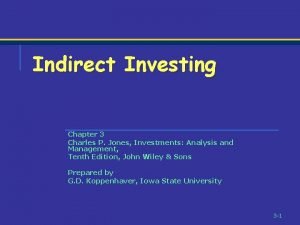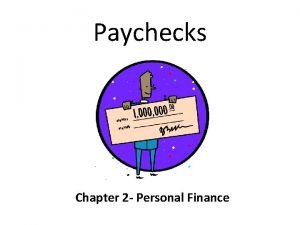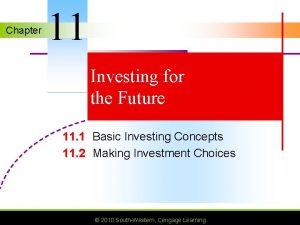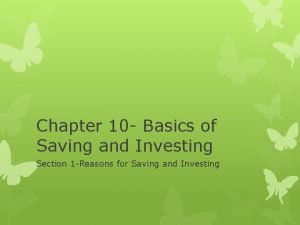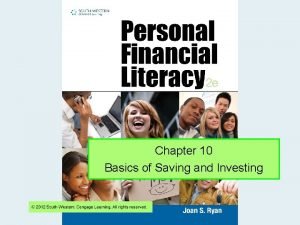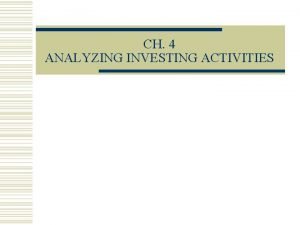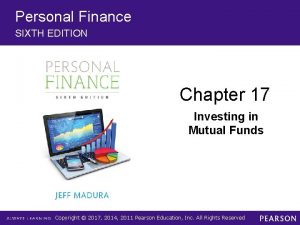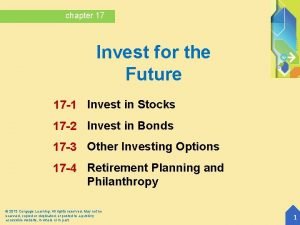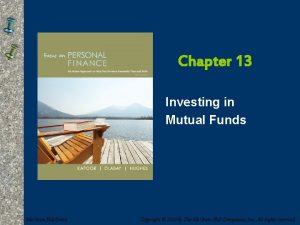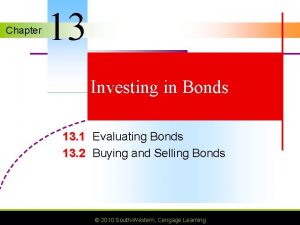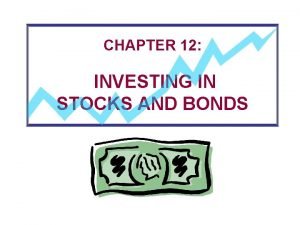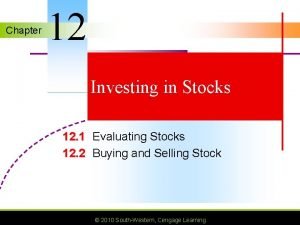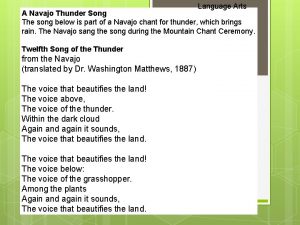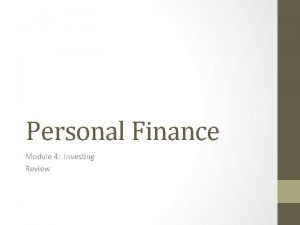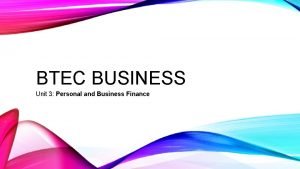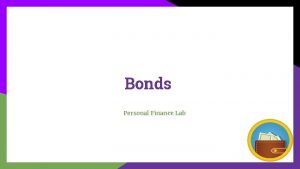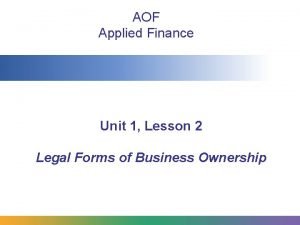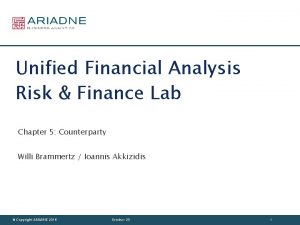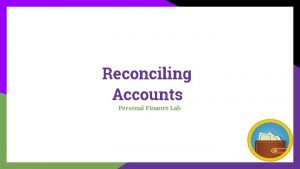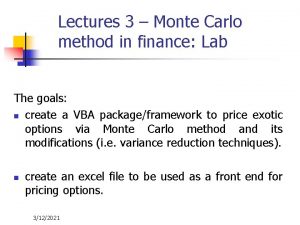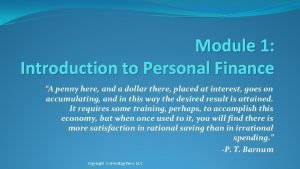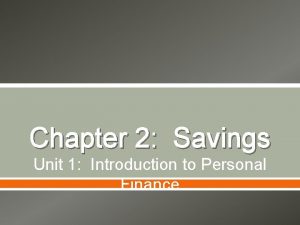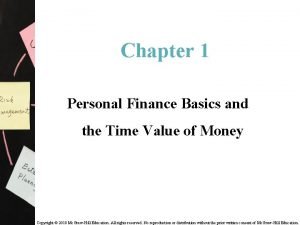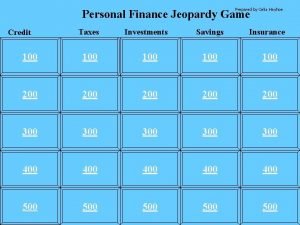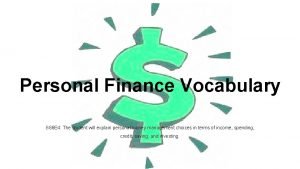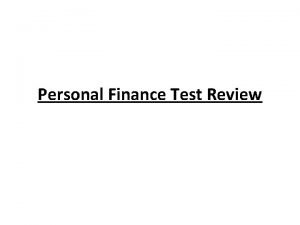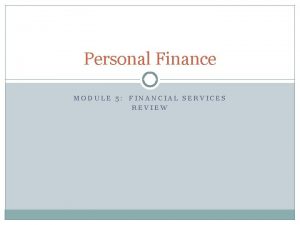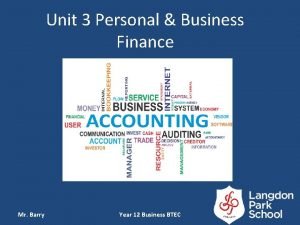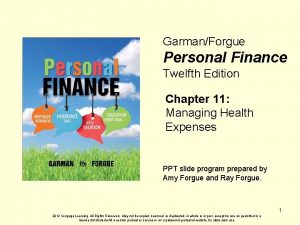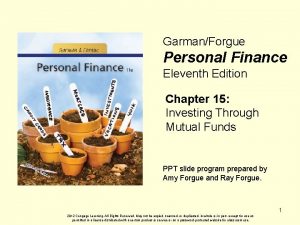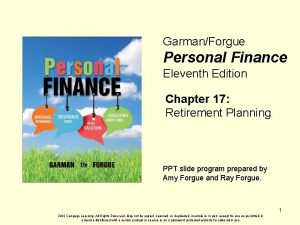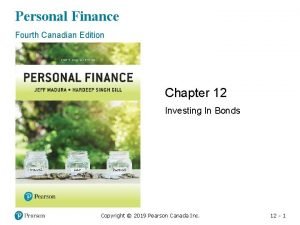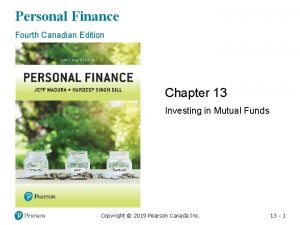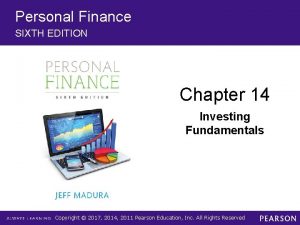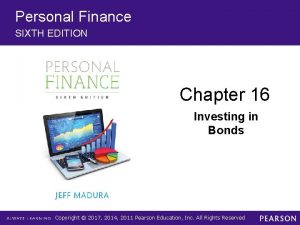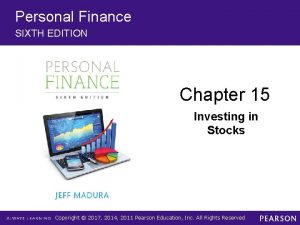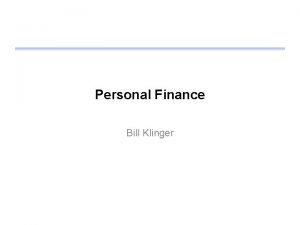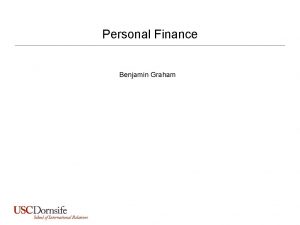GarmanForgue Personal Finance Twelfth Edition Chapter 14 Investing













































































- Slides: 77

Garman/Forgue Personal Finance Twelfth Edition Chapter 14: Investing in Stocks and Bonds PPT slide program prepared by Amy Forgue and Ray Forgue. 2012 Cengage Learning. All Rights Reserved. May not be copied, scanned, or duplicated, in whole or in part, except for use as permitted in a license distributed with a certain product or service or on a password-protected website for classroom use. 1

2

Introduction When you invest in stocks and bonds, you can increase returns significantly while increasing risk only slightly. Stocks and bonds provide opportunities for conservative, moderate, and aggressive investors alike. 2012 Cengage Learning. All Rights Reserved. May not be copied, scanned, or duplicated, in whole or in part, except for use as permitted in a license distributed with a certain product or service or on a password-protected website for classroom use. 3

Your Next Five Years In the next five years, you can start achieving financial success by doing the following related to investing in stocks and bonds: 1. Don’t be afraid of investing in the stock market so include stocks and bonds or mutual funds that own stocks and bonds in your investment portfolio. 2012 Cengage Learning. All Rights Reserved. May not be copied, scanned, or duplicated, in whole or in part, except for use as permitted in a license distributed with a certain product or service or on a password-protected website for classroom use. 4

Your Next Five Years 2. Use fundamental analysis to determine a company’s basic value before investing in any individual stock. 3. Resist putting money into so-called hot stocks. 2012 Cengage Learning. All Rights Reserved. May not be copied, scanned, or duplicated, in whole or in part, except for use as permitted in a license distributed with a certain product or service or on a password-protected website for classroom use. 5

Your Next Five Years 4. Invest part of the conservative portion of your portfolio in TIPS (Treasury Inflation. Protected Securities) to beat inflation. 5. When you have children, use zerocoupon bonds to help save for their education. 2012 Cengage Learning. All Rights Reserved. May not be copied, scanned, or duplicated, in whole or in part, except for use as permitted in a license distributed with a certain product or service or on a password-protected website for classroom use. 6

Learning Objective #1 Explain how stocks and bonds are used as investments. 2012 Cengage Learning. All Rights Reserved. May not be copied, scanned, or duplicated, in whole or in part, except for use as permitted in a license distributed with a certain product or service or on a password-protected website for classroom use. 7

The Role of Stocks and Bonds in Investments • Corporation • Privately Held Corporation • Public Corporation • Startup Capital 2012 Cengage Learning. All Rights Reserved. May not be copied, scanned, or duplicated, in whole or in part, except for use as permitted in a license distributed with a certain product or service or on a password-protected website for classroom use. 8

Common Stock • Stocks are shares of ownership in a business corporation’s assets and earnings. • Shareholder (or Stockholder) • Market Price • Cash Dividends 2012 Cengage Learning. All Rights Reserved. May not be copied, scanned, or duplicated, in whole or in part, except for use as permitted in a license distributed with a certain product or service or on a password-protected website for classroom use. 9

Common Stock • • • Residual Claim Limited Liability Voting Rights Board of Directors Professional Management 2012 Cengage Learning. All Rights Reserved. May not be copied, scanned, or duplicated, in whole or in part, except for use as permitted in a license distributed with a certain product or service or on a password-protected website for classroom use. 10

Preferred Stock • Cumulative Preferred Stock • Noncumulative Preferred Stock • Convertible Preferred Stock 2012 Cengage Learning. All Rights Reserved. May not be copied, scanned, or duplicated, in whole or in part, except for use as permitted in a license distributed with a certain product or service or on a password-protected website for classroom use. 11

Bonds • Bonds are interest-bearing, negotiable certificates of long-term debt. • Principal • Maturity Date 2012 Cengage Learning. All Rights Reserved. May not be copied, scanned, or duplicated, in whole or in part, except for use as permitted in a license distributed with a certain product or service or on a password-protected website for classroom use. 12

Concept Check 14. 1 • Distinguish between common stocks and bonds. • How do public corporations use stocks and bonds? • Why do individuals invest in stocks and bonds? 2012 Cengage Learning. All Rights Reserved. May not be copied, scanned, or duplicated, in whole or in part, except for use as permitted in a license distributed with a certain product or service or on a password-protected website for classroom use. 13

Learning Objective #2 Describe ways to evaluate stock prices, and calculate a stock’s potential rate of return. 2012 Cengage Learning. All Rights Reserved. May not be copied, scanned, or duplicated, in whole or in part, except for use as permitted in a license distributed with a certain product or service or on a password-protected website for classroom use. 14

The Major Characteristics of Common Stocks • Use Beta to Compare a Stock to Similar Investments – Beta (or Beta Value or Beta Coefficient): Measure of stock volatility. 2012 Cengage Learning. All Rights Reserved. May not be copied, scanned, or duplicated, in whole or in part, except for use as permitted in a license distributed with a certain product or service or on a password-protected website for classroom use. 15

JOY F CHH MSFT M APPL BRK. A PG Joy Global – Mining Equipment Ford Motor Corp – Automobiles Choice Hotels – Hotels Microsoft – IT Macy’s – Retail Apple – IT Berkshire-Hathaway – Holding Co. Proctor & Gamble – Home Products 2. 13 1. 31 1. 02. 90. 89. 87. 76. 57 16

How to Evaluate Stock Values • Use fundamental analysis to evaluate the financial strength of the company. • Use technical analysis to predict the success of a stock based on indicators of the workings of the market as a whole. 2012 Cengage Learning. All Rights Reserved. May not be copied, scanned, or duplicated, in whole or in part, except for use as permitted in a license distributed with a certain product or service or on a password-protected website for classroom use. 17

The Major Characteristics of Common Stocks • Income Stocks • Growth Stocks – Well-known growth stocks – Lesser-known growth stocks • Value Stocks 2012 Cengage Learning. All Rights Reserved. May not be copied, scanned, or duplicated, in whole or in part, except for use as permitted in a license distributed with a certain product or service or on a password-protected website for classroom use. 18

The Major Characteristics of Common Stocks • Most stocks are cyclical and some are countercyclical. – Cyclical stock – Countercyclical (or defensive) stock 2012 Cengage Learning. All Rights Reserved. May not be copied, scanned, or duplicated, in whole or in part, except for use as permitted in a license distributed with a certain product or service or on a password-protected website for classroom use. 19

The Major Characteristics of Common Stocks • • Speculative Stocks Tech Stocks Blue-Chip Stocks Large-cap, Mid-cap, Small-cap, and Microcap Stocks 2012 Cengage Learning. All Rights Reserved. May not be copied, scanned, or duplicated, in whole or in part, except for use as permitted in a license distributed with a certain product or service or on a password-protected website for classroom use. 20

How to Evaluate Stock Values • Corporate earnings are most important. – Earnings per share • Price/Earnings (or P/E) Ratio – Earnings Yield – Trailing P/E Ratio – Projected P/E (or Forward P/E) Ratio 2012 Cengage Learning. All Rights Reserved. May not be copied, scanned, or duplicated, in whole or in part, except for use as permitted in a license distributed with a certain product or service or on a password-protected website for classroom use. 21

Evaluating Common Stocks • Price-earnings growth ratio (PEG) • Price/Sales ratio 2015 Cengage Learning. All Rights Reserved. May not be copied, scanned, or duplicated, in whole or in part, except for use as permitted in a license distributed with a certain product or service or on a password-protected website for classroom use. 22

Numerical Measures to Evaluate Stock Prices – Cash Dividends – Dividends Per Share – Dividend Payout Ratio – Dividend Yield 2012 Cengage Learning. All Rights Reserved. May not be copied, scanned, or duplicated, in whole or in part, except for use as permitted in a license distributed with a certain product or service or on a password-protected website for classroom use. 23

Numerical Measures to Evaluate Stock Prices – Book Value Per Share – Price-to-Book Ratio – Match your investment choices to your goals using P/E ratio and Beta. 2012 Cengage Learning. All Rights Reserved. May not be copied, scanned, or duplicated, in whole or in part, except for use as permitted in a license distributed with a certain product or service or on a password-protected website for classroom use. 24

2012 Cengage Learning. All Rights Reserved. May not be copied, scanned, or duplicated, in whole or in part, except for use as permitted in a license distributed with a certain product or service or on a password-protected website for classroom use. 25

Calculating a Stock’s Potential Rate of Return • Use beta to estimate the risk of the investment. • Estimate the market risk (or systematic risk). • Calculate your required rate of return. • Calculate the stock’s potential return. • Compare required and potentials rates. 2015 Cengage Learning. All Rights Reserved. May not be copied, scanned, or duplicated, in whole or in part, except for use as permitted in a license distributed with a certain product or service or on a password-protected website for classroom use. 26

Calculate the Stock’s Potential Rate of Return • Add up projected income and price appreciation. – Potential Rate of Return – Approximate Compound Yield (or ACY) • Compare the required rate of return with the potential rate of return on the investment. 2012 Cengage Learning. All Rights Reserved. May not be copied, scanned, or duplicated, in whole or in part, except for use as permitted in a license distributed with a certain product or service or on a password-protected website for classroom use. 27

Concept Check 14. 2 • Distinguish between income stocks and growth stocks. • Explain how a value stock might or might not differ from a blue-chip stock or a tech stock. 2012 Cengage Learning. All Rights Reserved. May not be copied, scanned, or duplicated, in whole or in part, except for use as permitted in a license distributed with a certain product or service or on a password-protected website for classroom use. 29

Concept Check 14. 2 • Explain how a stock with a beta of 1. 0 differs from ones with a beta of 1. 2 and 2. 5. • What is the focus of fundamental analysis? • Summarize the meanings of the terms trailing and projected price/earnings ratio. 2015 Cengage Learning. All Rights Reserved. May not be copied, scanned, or duplicated, in whole or in part, except for use as permitted in a license distributed with a certain product or service or on a password-protected website for classroom use. 30

Concept Check 14. 2 • What is the focus of fundamental analysis? • Summarize the meanings of the terms trailing and projected price/earnings ratio. 2015 Cengage Learning. All Rights Reserved. May not be copied, scanned, or duplicated, in whole or in part, except for use as permitted in a license distributed with a certain product or service or on a password-protected website for classroom use. 31

Concept Check 14. 2 • List the fives steps to calculate a stock’s potential rate of return. 2015 Cengage Learning. All Rights Reserved. May not be copied, scanned, or duplicated, in whole or in part, except for use as permitted in a license distributed with a certain product or service or on a password-protected website for classroom use. 32

Learning Objective #3 Use the Internet to evaluate common stocks in which to invest. 2012 Cengage Learning. All Rights Reserved. May not be copied, scanned, or duplicated, in whole or in part, except for use as permitted in a license distributed with a certain product or service or on a password-protected website for classroom use. 33

2012 Cengage Learning. All Rights Reserved. May not be copied, scanned, or duplicated, in whole or in part, except for use as permitted in a license distributed with a certain product or service or on a password-protected website for classroom use. 34

Use the Internet to Evaluate and Select Stocks • Begin by setting criteria for your stock investments. • Basic investment information: – fool. com – morningstar. com – kiplinger. com/personalfinance/ – money. cnn. com/pf/indes. html • Set up your portfolio online 2012 Cengage Learning. All Rights Reserved. May not be copied, scanned, or duplicated, in whole or in part, except for use as permitted in a license distributed with a certain product or service or on a password-protected website for classroom use. 35

How To Use the Internet to Evaluate and Select Stocks • Stock-Screening Tools: – www. kiplinger. com/tools/stockscreener/inde x. html – http: //screen. morningstar. com/Stock. Selector. html • Stock History • Company Website 2012 Cengage Learning. All Rights Reserved. May not be copied, scanned, or duplicated, in whole or in part, except for use as permitted in a license distributed with a certain product or service or on a password-protected website for classroom use. 36

How To Use the Internet to Evaluate and Select Stocks • Security analysts’ research reports • The two most popular firms that offer stock advisory research services: – Morningstar – Value Line 2012 Cengage Learning. All Rights Reserved. May not be copied, scanned, or duplicated, in whole or in part, except for use as permitted in a license distributed with a certain product or service or on a password-protected website for classroom use. 37

How To Use the Internet to Evaluate and Select Stocks • Pay attention to economic trends – Stage in the business cycle – Inflation rates – Interest rates – Expected changes in these 2012 Cengage Learning. All Rights Reserved. May not be copied, scanned, or duplicated, in whole or in part, except for use as permitted in a license distributed with a certain product or service or on a password-protected website for classroom use. 38

How To Use the Internet to Evaluate and Select Stocks • Pay attention to securities market indexes – Dow Jones Industrial Average – Standard & Poor’s 500 Index – NASDAQ Composite Index – Russell 2000 Index – Wilshire 5000 Index 2012 Cengage Learning. All Rights Reserved. May not be copied, scanned, or duplicated, in whole or in part, except for use as permitted in a license distributed with a certain product or service or on a password-protected website for classroom use. 39

How To Use the Internet to Evaluate and Select Stocks • Securities exchanges (stock markets) • Over-The-Counter (or OTC) Marketplace 2012 Cengage Learning. All Rights Reserved. May not be copied, scanned, or duplicated, in whole or in part, except for use as permitted in a license distributed with a certain product or service or on a password-protected website for classroom use. 40

Figure 14 -2: How Stocks Are Quoted 2012 Cengage Learning. All Rights Reserved. May not be copied, scanned, or duplicated, in whole or in part, except for use as permitted in a license distributed with a certain product or service or on a password-protected website for classroom use. 41

42

How To Use the Internet to Evaluate and Select Stocks • Use portfolio tracking to monitor your investments: – E*Trade: us. etrade. com/e/t/home – MSN Money: moneycentral. msn. com – Morningstar: morningstar. com – Investor. Guide. com 2012 Cengage Learning. All Rights Reserved. May not be copied, scanned, or duplicated, in whole or in part, except for use as permitted in a license distributed with a certain product or service or on a password-protected website for classroom use. 43

Concept Check 14. 3 • Give three examples of the types of website resources available to investors on the Internet. • List five places where you can obtain investment information on a specific stock. 2012 Cengage Learning. All Rights Reserved. May not be copied, scanned, or duplicated, in whole or in part, except for use as permitted in a license distributed with a certain product or service or on a password-protected website for classroom use. 44

Concept Check 14. 3 • Distinguish between the Dow Jones Industrial Average and the S&P 500. • Where can you go to look up stock symbols and prices? 2012 Cengage Learning. All Rights Reserved. May not be copied, scanned, or duplicated, in whole or in part, except for use as permitted in a license distributed with a certain product or service or on a password-protected website for classroom use. 45

Learning Objective #4 Summarize how to buy and sell stocks, as well as the techniques of margin buying and selling short. . 2012 Cengage Learning. All Rights Reserved. May not be copied, scanned, or duplicated, in whole or in part, except for use as permitted in a license distributed with a certain product or service or on a password-protected website for classroom use. 46

Buying and Selling Stocks • Stockbroker (or Account Executive) • Security’s street name 2012 Cengage Learning. All Rights Reserved. May not be copied, scanned, or duplicated, in whole or in part, except for use as permitted in a license distributed with a certain product or service or on a password-protected website for classroom use. 47

Buying and Selling Stocks • Opening a brokerage account – Deposit as little as $1000 to open a cash account – You must settle any buy or sell orders within three days after the order has been given 2015 Cengage Learning. All Rights Reserved. May not be copied, scanned, or duplicated, in whole or in part, except for use as permitted in a license distributed with a certain product or service or on a password-protected website for classroom use. 48

Buying and Selling Stocks • Discount, online, and general (or full -service) brokers differ in level of commissions charged and amount of service provided. 2012 Cengage Learning. All Rights Reserved. May not be copied, scanned, or duplicated, in whole or in part, except for use as permitted in a license distributed with a certain product or service or on a password-protected website for classroom use. 49

Buying and Selling Stocks • Broker commissions and fees – Round Lots – Odd Lot – Differential: The odd-lot portion of the transaction. 2012 Cengage Learning. All Rights Reserved. May not be copied, scanned, or duplicated, in whole or in part, except for use as permitted in a license distributed with a certain product or service or on a password-protected website for classroom use. 50

Buying and Selling Stocks • How to order stock transactions: – The process of trading stocks involves a floor broker and a specialist. – Securities prices are either matched or negotiated. 2012 Cengage Learning. All Rights Reserved. May not be copied, scanned, or duplicated, in whole or in part, except for use as permitted in a license distributed with a certain product or service or on a password-protected website for classroom use. 51

2012 Cengage Learning. All Rights Reserved. May not be copied, scanned, or duplicated, in whole or in part, except for use as permitted in a license distributed with a certain product or service or on a password-protected website for classroom use. 52

Buying and Selling Stocks • Types of stock orders (executing an order): – Market order – Limit order – Stop order (or stop-loss order) – Time limits: fill-or-kill order, day order, open order 2012 Cengage Learning. All Rights Reserved. May not be copied, scanned, or duplicated, in whole or in part, except for use as permitted in a license distributed with a certain product or service or on a password-protected website for classroom use. 53

Buying and Selling Stocks • Margin buying and selling short are risky trading techniques. • Margin trading is buying stocks on credit (using a margin account). 2012 Cengage Learning. All Rights Reserved. May not be copied, scanned, or duplicated, in whole or in part, except for use as permitted in a license distributed with a certain product or service or on a password-protected website for classroom use. 54

Buying and Selling Stocks • Buying on margin can increase returns. • Buying on margin can also increase losses. • A margin call makes matters even worse. 2012 Cengage Learning. All Rights Reserved. May not be copied, scanned, or duplicated, in whole or in part, except for use as permitted in a license distributed with a certain product or service or on a password-protected website for classroom use. 55

Buying and Selling Stocks • Selling short is selling stock borrowed from your broker. – Buying long – Selling short 2012 Cengage Learning. All Rights Reserved. May not be copied, scanned, or duplicated, in whole or in part, except for use as permitted in a license distributed with a certain product or service or on a password-protected website for classroom use. 56

Concept Check 14. 4 • Summarize the differences among discount, online, and full-service brokers. • Summarize the differences among types of stock orders: market, limit, and stop order. 2012 Cengage Learning. All Rights Reserved. May not be copied, scanned, or duplicated, in whole or in part, except for use as permitted in a license distributed with a certain product or service or on a password-protected website for classroom use. 57

Concept Check 14. 4 • Explain what selling short is and how it can go wrong for an investor. 2012 Cengage Learning. All Rights Reserved. May not be copied, scanned, or duplicated, in whole or in part, except for use as permitted in a license distributed with a certain product or service or on a password-protected website for classroom use. 58

Learning Objective #5 Describe how to invest in bonds. 2012 Cengage Learning. All Rights Reserved. May not be copied, scanned, or duplicated, in whole or in part, except for use as permitted in a license distributed with a certain product or service or on a password-protected website for classroom use. 59

2012 Cengage Learning. All Rights Reserved. May not be copied, scanned, or duplicated, in whole or in part, except for use as permitted in a license distributed with a certain product or service or on a password-protected website for classroom use. 60

Investing In Bonds • Investment-Grade Bonds • Speculative Grade (or Junk) Bonds • Default Rate – www. bondpickers. com – www. defaultrisk. com 2012 Cengage Learning. All Rights Reserved. May not be copied, scanned, or duplicated, in whole or in part, except for use as permitted in a license distributed with a certain product or service or on a password-protected website for classroom use. 61

Figure 14 -4: Higher Returns Requires Greater Risk 2012 Cengage Learning. All Rights Reserved. May not be copied, scanned, or duplicated, in whole or in part, except for use as permitted in a license distributed with a certain product or service or on a password-protected website for classroom use. 62

Investing In Bonds • Corporate, U. S. government, and municipal bonds – Bond rating – Default (or Credit) risk 2012 Cengage Learning. All Rights Reserved. May not be copied, scanned, or duplicated, in whole or in part, except for use as permitted in a license distributed with a certain product or service or on a password-protected website for classroom use. 63

Table 14 -3: Summary of Bond Ratings Moody’s Aaa–A Baa-Ba B-Ca C S&P AAA-A BBB-B CCC-C DDD-D Description High Quality Medium Quality P and I at Risk In Default 2012 Cengage Learning. All Rights Reserved. May not be copied, scanned, or duplicated, in whole or in part, except for use as permitted in a license distributed with a certain product or service or on a password-protected website for classroom use. 64

Investing In Bonds • Treasury bills (t-bills), notes, and bonds – Discount yield, I-bonds – TIPS (or Treasury Inflation-Protected Securities) – Series EE savings bonds – Federal agency debt issues 2012 Cengage Learning. All Rights Reserved. May not be copied, scanned, or duplicated, in whole or in part, except for use as permitted in a license distributed with a certain product or service or on a password-protected website for classroom use. 65

Investing In Bonds • Municipal Government Bonds (or Munis) • Tax-Free (or Tax-Exempt) Bonds 2012 Cengage Learning. All Rights Reserved. May not be copied, scanned, or duplicated, in whole or in part, except for use as permitted in a license distributed with a certain product or service or on a password-protected website for classroom use. 66

Investing In Bonds • Unique characteristics of bond investing: – Coupon rate (or coupon, coupon yield, or stated interest rate) – Serial Redemption or Sinking Fund – Secured bond or unsecured bond (debenture) 2012 Cengage Learning. All Rights Reserved. May not be copied, scanned, or duplicated, in whole or in part, except for use as permitted in a license distributed with a certain product or service or on a password-protected website for classroom use. 67

68

Investing In Bonds • Unique characteristics of bond investing: – Registered and Issued – Book Entry – Callable 2012 Cengage Learning. All Rights Reserved. May not be copied, scanned, or duplicated, in whole or in part, except for use as permitted in a license distributed with a certain product or service or on a password-protected website for classroom use. 69

Evaluating Bond Prices and Returns • Interest rate risk results in variable value. – Market interest rates – Interest rate risk – Fixed yield versus variable value – Premiums and discounts 2012 Cengage Learning. All Rights Reserved. May not be copied, scanned, or duplicated, in whole or in part, except for use as permitted in a license distributed with a certain product or service or on a password-protected website for classroom use. 70

Evaluating Bond Prices and Returns • Present value of a bond • Current yield • Yield to maturity 2012 Cengage Learning. All Rights Reserved. May not be copied, scanned, or duplicated, in whole or in part, except for use as permitted in a license distributed with a certain product or service or on a password-protected website for classroom use. 71

Concept Check 14. 5 • Distinguish between investment- and speculative-grade bonds. • Give some reasons why individuals often invest in corporate bonds rather than Treasuries. 2012 Cengage Learning. All Rights Reserved. May not be copied, scanned, or duplicated, in whole or in part, except for use as permitted in a license distributed with a certain product or service or on a password-protected website for classroom use. 72

Concept Check 14. 5 • Summarize the differences among Treasury bonds, I bonds, and TIPS bonds. • Explain what interest rate risk is and tell what calculation individuals considering bond investments should use to avoid that problem when buying an existing bond. 2012 Cengage Learning. All Rights Reserved. May not be copied, scanned, or duplicated, in whole or in part, except for use as permitted in a license distributed with a certain product or service or on a password-protected website for classroom use. 73

Worst Financial Blunders in Investing in Stocks and Bonds Based on others’ financial woes, you will make mistakes in personal finance when you: 1. Invest in stocks that do not match your investment philosophy, 2. Fail to use fundamental analysis when making stock investments. 2012 Cengage Learning. All Rights Reserved. May not be copied, scanned, or duplicated, in whole or in part, except for use as permitted in a license distributed with a certain product or service or on a password-protected website for classroom use. 74

Worst Financial Blunders in Investing in Stocks and Bonds 3. Buy stocks on margin or sell short. 2012 Cengage Learning. All Rights Reserved. May not be copied, scanned, or duplicated, in whole or in part, except for use as permitted in a license distributed with a certain product or service or on a password-protected website for classroom use. 75

Do It NOW! You know more about personal finance after reading this chapter, so get started right now by: 1. Identifying three types of stocks that are appropriate for your investment goals and selecting an example of each. 2012 Cengage Learning. All Rights Reserved. May not be copied, scanned, or duplicated, in whole or in part, except for use as permitted in a license distributed with a certain product or service or on a password-protected website for classroom use. 76

Do It NOW! 2. Following the fluctuations of those stocks for two months. 3. Considering a bond investment of a corporate bond by selecting one, and researching its price, and bond rating. 2012 Cengage Learning. All Rights Reserved. May not be copied, scanned, or duplicated, in whole or in part, except for use as permitted in a license distributed with a certain product or service or on a password-protected website for classroom use. 77

2012 Cengage Learning. All Rights Reserved. May not be copied, scanned, or duplicated, in whole or in part, except for use as permitted in a license distributed with a certain product or service or on a password-protected website for classroom use. 81
 Direct investing vs indirect investing
Direct investing vs indirect investing Ricky w griffin management 12th edition pdf
Ricky w griffin management 12th edition pdf Chapter 8 personal finance
Chapter 8 personal finance Chapter 2 personal finance
Chapter 2 personal finance Overview of personal finance chapter 1
Overview of personal finance chapter 1 Chapter 8 personal finance
Chapter 8 personal finance Chapter 4 post test personal finance
Chapter 4 post test personal finance Chapter 1 post test personal finance
Chapter 1 post test personal finance Overview of personal finance chapter 1
Overview of personal finance chapter 1 Fundamentals of corporate finance, third canadian edition
Fundamentals of corporate finance, third canadian edition Corporate finance tenth edition
Corporate finance tenth edition Fundamentals of corporate finance third canadian edition
Fundamentals of corporate finance third canadian edition Fundamentals of corporate finance fifth edition
Fundamentals of corporate finance fifth edition Fundamentals of corporate finance 6th edition
Fundamentals of corporate finance 6th edition Corporate finance tenth edition
Corporate finance tenth edition Corporate finance tenth edition
Corporate finance tenth edition Corporate finance tenth edition
Corporate finance tenth edition Corporate finance tenth edition
Corporate finance tenth edition The spreading of risk among many types of investments
The spreading of risk among many types of investments Chapter 10 basics of saving and investing
Chapter 10 basics of saving and investing Holding a variety of investments to reduce risk
Holding a variety of investments to reduce risk Chapter 6 saving and investing
Chapter 6 saving and investing Analyzing investing activities
Analyzing investing activities Chapter 17 investing in stocks
Chapter 17 investing in stocks Chapter 17 investing in stocks
Chapter 17 investing in stocks Chapter 13 investing in mutual funds
Chapter 13 investing in mutual funds Chapter 13 investing in bonds
Chapter 13 investing in bonds Chapter 12 investing in stocks
Chapter 12 investing in stocks Chapter 12 investing in stocks
Chapter 12 investing in stocks Using mis 10th edition
Using mis 10th edition Using mis (10th edition) 10th edition
Using mis (10th edition) 10th edition Night structure
Night structure Twelfth night ppt
Twelfth night ppt I will drop in his way some obscure epistles of love
I will drop in his way some obscure epistles of love Twelfth night characters
Twelfth night characters What is the main conflict in twelfth night
What is the main conflict in twelfth night Act 2 scene 4 twelfth night summary
Act 2 scene 4 twelfth night summary Duke orsino
Duke orsino Themes in twelfth night
Themes in twelfth night Twelfth song of thunder figurative language
Twelfth song of thunder figurative language Twelfth night act 5
Twelfth night act 5 Stock characters in twelfth night
Stock characters in twelfth night Jenny phelps
Jenny phelps Msik
Msik Satire in twelfth night
Satire in twelfth night Deverell twelfth night
Deverell twelfth night I disappeared on the night before my twelfth birthday
I disappeared on the night before my twelfth birthday Ironic and humorous plays
Ironic and humorous plays Module 4 investing
Module 4 investing Personal finance gcse
Personal finance gcse Mypersonalfinancelab
Mypersonalfinancelab Btec level 3 unit 3 personal and business finance
Btec level 3 unit 3 personal and business finance Personal finance lab
Personal finance lab Llc advantages and disadvantages
Llc advantages and disadvantages Personal finance lab
Personal finance lab Personal life cycle finance
Personal life cycle finance Personal finance lab
Personal finance lab Personal finance bell ringers
Personal finance bell ringers Personal finance assignment
Personal finance assignment Personal finance lab
Personal finance lab Introduction to personal finance
Introduction to personal finance Principles of business and finance
Principles of business and finance Personal finance unit 1 review
Personal finance unit 1 review Personal finance module
Personal finance module Glencoe personal finance
Glencoe personal finance Five foundations of personal finance definition
Five foundations of personal finance definition Personal finance basics and the time value of money
Personal finance basics and the time value of money Personal finance budget project
Personal finance budget project Personal finance jeopardy
Personal finance jeopardy Financial vocabulary for students
Financial vocabulary for students Personal finance test 1
Personal finance test 1 Personal finance project
Personal finance project Personal finance notes
Personal finance notes Personal finance module
Personal finance module Personal finance principles
Personal finance principles Personal finance final exam review
Personal finance final exam review Chapter 11 finances and career planning
Chapter 11 finances and career planning Personal business finance
Personal business finance
